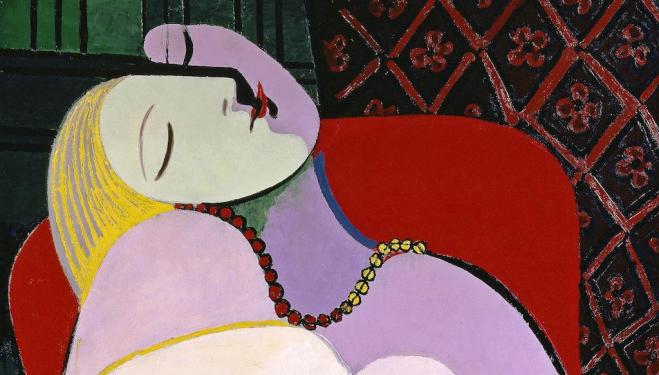
Review: Picasso 1932: Love, Fame, Tragedy
'You have an interesting face,' he told her. 'I am Picasso. You and I are going to do great things together.'
Thus began one of the best known love affairs of the 20th Century. Marie-Thérèse Walter was 17, the artist 45. This dizzying passion was at the core of Picasso's annus mirabilis, a year in which love, fame and tragedy also played pivotal roles. 1932 was an extraordinary time for the artist, and so the art world as a whole. With Walter as his muse, Picasso produced some of the most charged and erotic artworks of his career.
In 1932 Picasso was 50. He lived with his wife Olga and his son Paulo between a lavish appartment in Paris and a rurual estate in Boisgeloup. He wore Saville Row suits, mingled with Paris high society and painted prolifically, desperate to prove his relevance in a Surrealist-dominated landscape. The output of this most intense year is now the subject of an extensive once-in-a-lifetime exhibition at Tate Modern. Transferring from the Musée National Picasso-Paris, Picasso 1932 is Tate's only Picasso retrospective to date and its landmark exhibition of the year.

Woman lying in the Sun on the Beach (MP1069). Pablo Picasso, 25 March 1932. Boisgeloup. Paris, musée national Picasso-Paris. Photo ©RMN-Grand Palais (musée national Picasso-Paris)/Thierry Le Mage © Succession Picasso – gestion droits d’auteur
More than 100 outstanding paintings, sculptures and works on paper pay heed to Picasso's tireless powers of invention, helping to pick apart the common myths and inaccuracies that we take as writ. Curated chronologically from January through December of 1932, we penetrate Picasso's 'year of wonders': three protagonists take centre stage: Olga (Picasso's wife), Marie-Thérèse (Picasso's mistress) and Picasso himself.
In 1932 Picasso painted in sporadic bursts creating more than 300 works: landscapes, abstract portraits, nudes, sketches, oils, photographs and sculpture rub shoudlers as if pages of a visual diary. Inextricably linked to his personal life, these works unveil Picasso as never before: 'I paint the way people write an autobiography', the artist once said.

Pablo Picasso, The Dream (private collection). 1932. Oil on canvas. Private collection of Steven Cohen© Christie’s Images / Bridgeman Images © Succession Picasso 2017
Picasso's portraits of Walter are the most provocative on display. Walter is everywhere. She swims, she reclines nude, she stares back at you, she sleeps. Picasso's lines, colours, distorted shapes draw you in to their passionate but contorted affair. In gallery four, three breath-taking nudes of Walter hang handsomely side by side.
Reunited for the first time since 1932, it's entrancing to see them all together. But the knock-out work is Le Rêve (pictured above). Depicting Walter asleep, the serenity of the scene is punctured when you spot the engorged penis that makes up her upturned face. Scandalous, and undeniably erotic, Picasso's passion for his young, sensual mistress is unmistakable. His 'explosive energy' strides forth striking the viewer like a bolt of electricity.
Picasso's portraits of Walter ooze a 'sexual energy' that establishes a staunchly erotic atmosphere in the white washed galleries of Tate Modern. But his portraits of other women are just as salacious. In March 1932, Picasso painted six nudes in ten days. A little later, he explored the dark realms of the uconscious. Boneless bodies wrap around themselves, arms metamorphose into octupus-like tenticles, the human body seems to regress to a pre-birth state. Boundaries are blurred, forms merge, bodies become one. Sex as depicted like never before.
But it's clear Picasso's women are unashamedly bled dry for his art. Exploited, driven to despair, and even suicide – Jacqueline Roque, Picasso's second wife, took her life in 1986 – Picasso's muses are Picasso's possessions. They serve him and him alone.

Pablo Picasso, A Girl Before a Mirror, 1932
But among these glorious portraits of Picasso's lovers, are rainy landscapes of Boisgeloup, Surrealist experiments, including thirteen seminal ink drawings of the Crucifixion, and intimate portraits of his family painted for his 1932 retrospective at Galeries Georges Petit. We also see drawings, sculptures, contemporary reviews, photographs, postcards, and snippets of his first catalogue raisonnée that let us into his world. Savagery combined with so much intimacy embalms Tate's lofty chambers.
Taken as one, this extravagantly choreographed show traces Picasso's personal journey in love, life and tragedy that pushed the artist to the height of his creative power. While the biographical nature of this show is sure to raise a few eyebrows, this is unmissable stuff that attempts to dismantle the myth around the man we think we know so well. Picasso 1932 is erotic, often brutal but everything we hoped it would be.

citizenM Gare du Lyon. Image: Culture Whisper
Earlier this year we nipped across the channel to preview Picasso 1932 in Musée National Picasso-Paris, as we couldn't resist a sneak peek of the exhibition billed to be one of the most significant shows to land at Tate Modern this year. Arriving on a late-afternoon train, we powered through Paris 1932 in a couple of hours, retiring to citizenM Gare du Lyon (just a stone's throw away from Musée National Picasso-Paris) for a post-exhibition debrief. With a super central Paris location, and on-trend design-led interiors, citizenM Gare du Lyon is a fantastic option for those in search of affordable luxury, and who have a jam-packed cultural agenda, like us. Following a wonderfully comfortable one night stay we hopped back on the Eurostar first thing the following morning to write up our review. Anything is doable when it comes to Picasso!
| What | Picasso 1932: Love, Fame, Tragedy , Tate Modern |
| Where | Tate Modern, Bankside, London, SE1 9TG | MAP |
| Nearest tube | Southwark (underground) |
| When |
08 Mar 18 – 10 Sep 18, Sunday to Thursday 10.00-18.00 Friday to Saturday 10.00-22.00 |
| Price | £22 |
| Website | Click here for more information |




